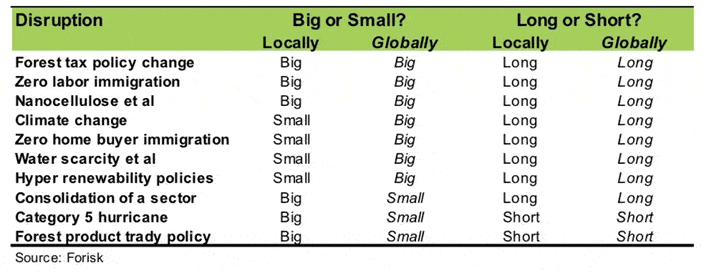This article builds on “A Framework for Changes that Could Disrupt the Forest Industry”, my previous LANDTHINK post that introduced a simple approach to organize our thinking around the magnitude and duration of potential disruptions on forestry or mill investments, good or bad. Here we localize the approach and apply it to sort a broad range of potential disruptions for developing investment strategies.
Local or Global?
Big changes can affect us locally, globally, or both. As we have long taught, timber markets are uniquely local. For strategy development, we want to specify the context of the disruption to best understand its absolute and relative risks, whether positive or negative.
Consider the example of Hurricane Katrina, a Category 5 event. Our summary evaluation of the disruption concludes:
- Big or small? Big event locally; devastating to some forests and damaging to many.
- Long or short? Short-term increase in supplies; negative impact on value.
Figure A further refines this assessment of a major hurricane and reinforces the point that, while severe and impactful, it remains an operational exposure and requires a tactical response. The event is short-term because it did not change the long-term fundamentals of wood demand or forest ownership.
Figure A. Ranking Disruptions: Example of Hurricane Katrina

This high-level framework prioritizes the relative importance of potential disruptions. It separates the local, tactical issues from the global and strategic. Now we apply this approach to a broader set of potential disruptions.
Ranking Disruptions for Forest Owners
Our current research into forest industry and timberland investment strategies includes analysis of over 30 actual and potential disruptions relevant to physical, economic, legislative, technological, market, and geopolitical exposures. Figure B summarizes an analysis and ranking for ten selected disruptions based on a forest owner point of view (as opposed to a wood user or manufacturer). This ranks first for global (strategic) exposures and second for local impacts. Each assessment has a “story” that changes based on the profile, objectives and assets of the firm.
Figure B. Ranking Ten Select Potential Disruptions (Forest Owner View)

Even at this level, the relative ranking highlights critical themes.
- Tax and environmental policies matter. Overall, forestry is a strategic asset and a low margin business that requires long-term commitments. Changes in how forest management costs get expensed or capitalized materially affect the profitability and attractiveness of these investments. And environmental policies that recognize forest benefits without constraining property rights can enhance these values materially.
- People matter. Without people to work and to consume, forests have little economic value. Anything that slows or hinders the growth of the workforce or of a healthy populace, materially reduces the net cash to owners, the long-term demand for manufacturers, and their ability to run a business.
- Technology matters. Technology has explosive potential as a value creator. Consider that pulp manufactured from pine as we know it did not exist 100 years ago. Today, fluff pulp mills have among the strongest ability-to-pay for wood in North America. The number of patents and applications for wood fiber continues to grow.
- Demand matters. From an economic standpoint, trees have no value unless nearby mills exist to buy them and convert them to value added products.
All timberland investment strategies can basically be summarized as efforts to match, model and exploit cash flows from wood markets and forest supplies of varying levels of maturity over time. When investing in U.S. timberland, we either invest in established forests with mature wood markets, or we invest in areas that require development of the forests and/or wood markets. And we must evaluate potential disruptions relative to the specific assets, market and strategy under consideration.
This content may not be used or reproduced in any manner whatsoever, in part or in whole, without written permission of LANDTHINK. Use of this content without permission is a violation of federal copyright law. The articles, posts, comments, opinions and information provided by LANDTHINK are for informational and research purposes only and DOES NOT substitute or coincide with the advice of an attorney, accountant, real estate broker or any other licensed real estate professional. LANDTHINK strongly advises visitors and readers to seek their own professional guidance and advice related to buying, investing in or selling real estate.










Add Comment